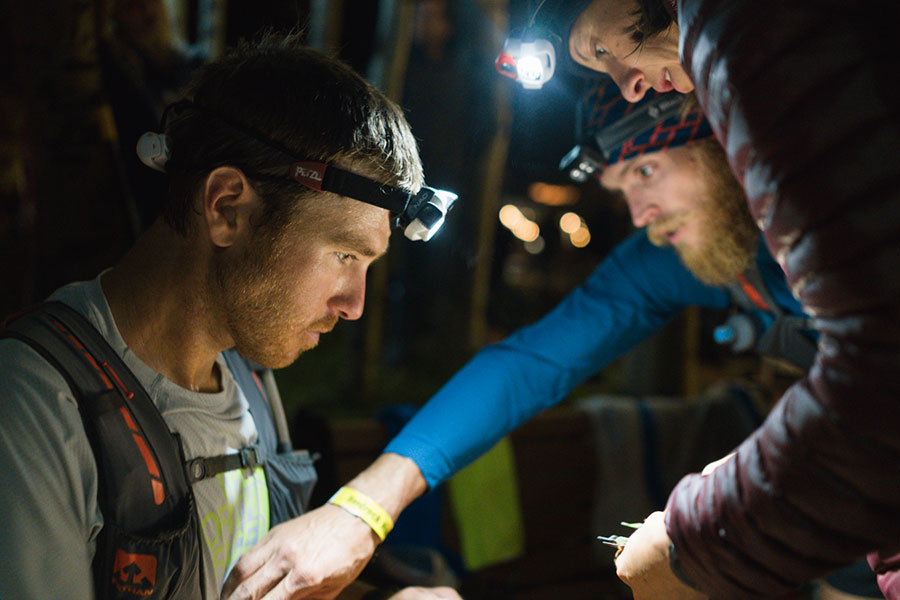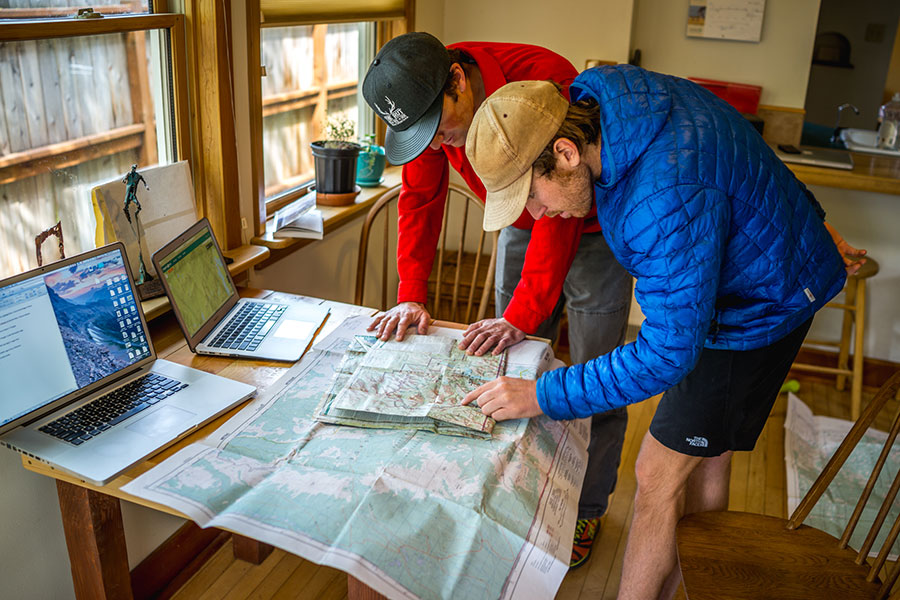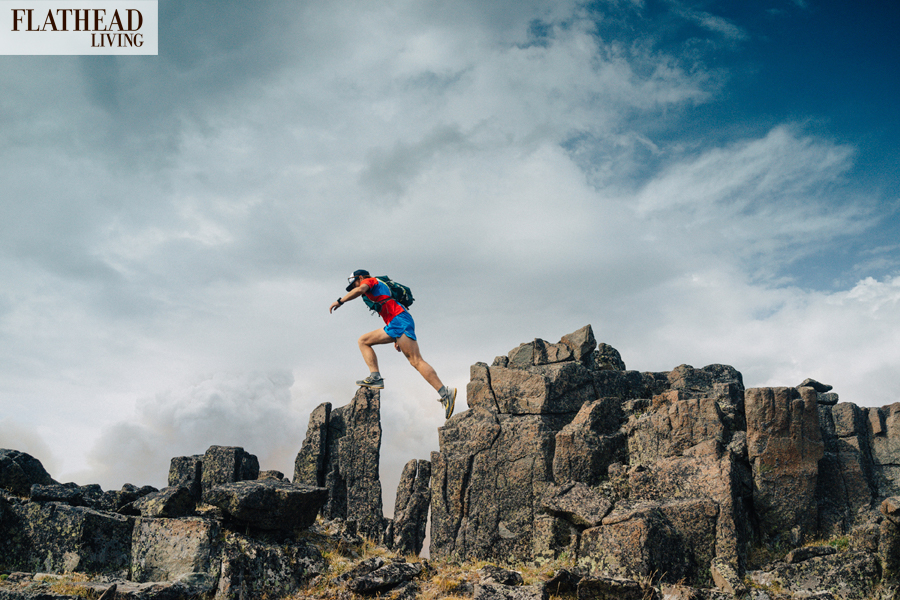Equipped with one of the most fitting names ever furnished on a shoe salesman and elite ultrarunner, Mike Foote’s entrée into the sport’s upper echelons has an unlikely provenance.
Foote’s transformation from average runner to elite ultra-distance trail and mountain runner was inspired by the allure of wild, rocky terrain in Northwest Montana and luck of the draw.
During his early-to-mid 20s, Foote worked as a backpacking and rafting guide in Glacier National Park during the summer and on ski patrol at Whitefish Mountain Resort on Big Mountain during the winter.
“I feel like Glacier National Park is my true north,” Foote said. “I feel like my coming of age in the mountains was in my 20s, and that’s when I lived in Whitefish in the winters and in Glacier in the summers. Glacier was the area that inspired me to do longer mountain days, and that turned into trail running, but it was about being able to run long distances in this incredible landscape that inspired me. That was the beginning of my passion for mountain running.”
By 2009, he had developed a powerful appetite for long-distance mountain running as a means to explore large swaths of Glacier’s more than 1 million acres of wilderness, running ridges and linking up peak enchainments that transported him deeper into the park’s rugged interior.
Competitive by nature, he thought the concept of ultrarunning sounded compelling and figured it might be a natural progression for him.
Inexplicably, he set his sights on the Wasatch 100 in Utah, one of the most grueling 100-mile footraces in the world, and which requires entrants to apply through a lottery system.

The chances of Foote landing on the limited roster of runners was remote, but on the final day to register for the lottery he applied on a whim, and with a portentous stroke of beginner’s luck he was selected. He started running higher mileage and signed up for tune-up races in Montana, including the HURL Elkhorn 50-miler in Helena, which he won handily by nearly 2 hours.
At Wasatch, he posted a respectable ninth-place finish, an impressive feat for anyone but especially for a novice ultrarunner, a transplant from Ohio who describes his sporting background this way: “I was a chubby kid who played baseball growing up.”
In 2011, Foote earned a sponsorship from The North Face after he became the top American finisher at the Ultra Trail du Mont Blanc (UTMB), a 100-mile race through the French, Italian and Swiss Alps, often thought of as the sport’s marquee event. A year later, he won the Ultramaraton de los Andes in Chile, set a course record at Wyoming’s Bighorn 100 and finished third at UTMB, again crossing the finish line as the first American in back-to-back races.
The 33-year-old’s running résumé has continued to grow and now includes three second-place finishes at the Hardrock 100, an unimaginably difficult endurance run through the San Juan Mountains of Colorado, featuring a cumulative vertical gain of 33,050 feet of climbing and 33,050 feet of descent, for a total elevation change of 66,100 feet. It also takes place at an average elevation of about 11,000 feet, with a high point of 14,048 feet.
He finished his most recent Hardrock in mid-July, in a time of 24 hours, 55 minutes, about 20 minutes behind Kilian Jornet, the Catalonian wunderkind widely thought to be unbeatable, as well as superhuman.

In early September, Foote hung up his racing shoes and donned his race-director hat at the Rut 50K in Big Sky, which he cofounded in 2013 alongside The North Face ultrarunner Mike Wolfe. During the race’s inaugural year, 400 runners competed; today, it’s part of the Sky Runner World Series, an international championship of high-altitude endurance races. It’s the only North American race featured in the series, and this year had 2,500 runners.
While Foote is surprised by the race’s immediate success, looking back on the timing, which coincides with a sharp rise in trail running’s popularity as a competitive sport, he says it make sense.
“Mike Wolfe and I have done a lot of racing in Europe where trail running is celebrated at a much higher level and attendance rates are higher, both that of the runners and spectators,” Foote said. “The courses are also much higher, and we started thinking about putting something on in Montana. Big Sky made the most sense because it has such great, gnarly terrain and the facilities to hold an event of that size.”
“It’s crazy, though,” he continued. “The Rut has become one of the biggest trail-running events in America, and it’s the only stop on the Sky Runner World Series, which is the most heralded trail-running series in the world. The fastest mountain-running athletes come every year and partake in it, so it is obviously something that people were interested in having over here.”

Despite Foote’s high-caliber racing portfolio and his aptitude as an event organizer (his day job is the events director for the Runner’s Edge, a running store in Missoula), he exhibits the most enthusiasm when discussing a passion project rooted in the conservation of wild spaces.
In the fall of 2015, Foote, Wolfe and Whitefish-born photographer Steven Gnam set out on a journey to experience and record the sprawling landscape known as the Crown of the Continent, an 18-million-acre chunk of interconnected ecosystems spanning 600 miles between Missoula and Banff, Alberta.
The Crown is where the Rocky Mountains run high and unbroken between the Blackfoot River drainage and Elk Lakes Provincial Park in British Columbia, the crest of which is the Continental Divide. The headwaters of the Pacific, Atlantic and Hudson Bay begin in the Crown, which encompasses Glacier Park and the Bob Marshall Wilderness Complex, and creates one of two intact ecosystems remaining in the Lower 48 in which grizzlies, elk, moose, wolverines, and wolves thrive.
Over the course of 24 days, the trio of runners tracked along high mountain ridgelines whenever possible, abjuring trails and roads in favor of unforgiving terrain, which allowed them to experience the landscape in as primal of a fashion as possible, linking together the Rattlesnake, Mission, Swan, and Flathead mountain ranges, and crossing through a patchwork of protected areas including the Waterton-Glacier International Peace Park.

They packed light, carrying just enough water, food and layers to complete their day, while a one-man support crew met them at points along the way to replenish supplies, transport shelter and assist with logistics.
Foote and Gnam conceived of the idea for the trip during a run in Missoula while Gnam was promoting his book, “Crown of the Continent: The Wildest Rockies,” which captures the wild beauty of the Crown through photography while attaching conservation and economic value to the region through a series of essays.
The run helped raise awareness of the Crown of the Continent, a mission-driven adventure that was instantly appealing to Foote, who harbored similar fantasies about combining his passion for running with his belief in preserving wild places.
“I am the type of person who is very much inspired by landscapes,” Foote said. “I love to compete and I love to race big races, but that happens like two or three days a year, and there’s another hundred-plus days a year when I am just getting out in the mountains.”
“The Crown of the Continent is my backyard, and it has always been very compelling me to spend time out there,” he added. “That trip was such an opportunity to delve deeply into it and gain a firsthand experience of traveling through that landscape for weeks on end. It is a really special place in the context of the Lower 48, and because it is such a large protected area, it definitely inspires me to do what I can to work and protect open spaces.”
To that end, Foote recently joined the board of the Missoula-based Five Valleys Land Trust, an organization that works to protect western Montana’s open spaces through conservation easements and other measures.
“That has been super fulfilling because it is so tangible,” Foote said. “I’m able to have these direct impacts on a place that I love.
Read more of our best long-form journalism in Flathead Living. Pick up the fall edition for free on newsstands across the valley. Or check it out online at flatheadliving.com.
